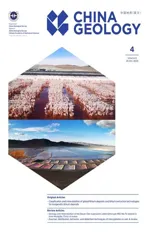Melt extraction and mineralization: A case study from the Shuangjianzishan supergiant Ag-Pb-Zn deposit (208 Mt), Inner Mongolia, NE China
2023-12-15MengDiGungshengYnYongshengLiWeninJiFnyuQiXingJu
Meng Di, Gung-sheng Yn, Yong-sheng Li, Wen-in Ji, Fn-yu Qi, Xing Ju
a China Aero Geophysical and Remote Sensing Center for Natural Resources, China Geology Survey, Ministry of Natural Resources, Beijing 100083, China
b Chinese Academy of Geological Sciences, China Geology Survey, Ministry of Natural Resources, Beijing 100037, China
c Development and Research Center, China Geology Survey, Ministry of Natural Resources, Beijing 100037, China
Keywords:Ag-Pb-Zn deposit D-O-C-He-Ar isotope In-situ S and Pb isotope analysis Melt extraction Ore-forming fluid Syenogranite Metallogenic belt Mineral exploration engineering Southern Great Hinggan Range
ABSTRACT The supergiant Shuangjianzishan (SJZ) Ag-Pb-Zn deposit is in the southern segment of the Great Hinggan Range (SGHR), northeast China.Previous studies suggest the ore-forming material and fluid originated from the magmatic system, and the mineralization age was consistent with the diagenetic age.However,the relationship between granitic magmatism and mineralization is still unclear in the SJZ.In this study, CH-O-He-Ar and in-situ S-Pb isotope analyses were conducted to determine the sources of ore-forming fluids and metals, which were combined with geochemistry data of SJZ granitoids from previous studies to constrain the relationship between the magmatism and the mineralization.The C-H-O-He-Ar-S-Pb isotopic compositions suggested the SJZ ore-forming material and fluids were derived from a magmatic source, which has mixed a small amount of mantle-derived materials.In addition, the disseminated sulfide from the syenogranite has comparable S-Pb isotopic composition with the sulfide minerals from ore veins,suggesting that the generation of the SJZ ore-forming fluids has a close relationship with the syenogranite magmatism.Combining with the geochemical characters of the syenogranite, the authors proposed that the mantle-derived fingerprint of the SJZ ore-forming fluid might be caused by the parent magma of the syenogranite, which was derived from partial melting of the juvenile lower crust, and underwent the residual melts segregated from a crystal mush in the shallow magma reservoir.The extraction of the syenogranite parent magma further concentrated the fertilized fluids, which was crucial to mineralization of the SJZ Ag-Pb-Zn deposit.©2023 China Geology Editorial Office.
1.Introduction
The supergiant Shuangjianzishan (SJZ) Ag-Pb-Zn deposit is located in the southern Great Hinggan Range (SGHR),which reported proven reserves of 161.22×106Mt ore volume, Ag metal content 15.5×103Mt, Pb metal content 392×103Mt, and Zn metal content 392×103Mt (Wang XD et al., 2018).The SJZ Ag-Pb-Zn deposit and other adjacent Cu-Mo-Pb-Zn-Ag deposits constitute one of the most important Cu-Sn-Ag-Pb-Zn polymetals producing regions of China (Shu QH et al., 2013; Jiang SH et al., 2011a, 2011b, 2017; Liu YF et al., 2016a, 2017; Liu LH, 2018; Zhai DG et al., 2017,2018a; Yang H et al., 2020; Jiang B et al., 2022).
Previous studies pointed out that the SGHR Mesozoic mineralization was triggered by the Mesozoic intensive magmatism, which was caused by the subduction and collisional events of the Mongol-Okhotsk Ocean, and the Paleo-Pacific Ocean (Liu C et al., 2011; Nie FJ et al., 2007;Xiao WJ et al., 2009; Xu B et al., 2015; Jiang SH et al., 2017;Li JY et al., 2021).The ore-bodies of the SJZ Ag-Pb-Zn deposit are hosted around intermediate-acid intrusions emplaced into adjacent terranes, which is the same as other polymetallic deposits (Cu-Mo-Pb-Zn-Ag) in the world (Baker T et al., 2004).The spatial and temporal relationships between intrusions and polymetallic-vein mineralization have been documented in the SJZ Ag-Pb-Zn deposits (Zhai DG et al.,2020; Zhang SH et al, 2019; Dai M et al., 2022).However,these polymetallic veins do not show a genetic relationship to the intrusions in the SJZ Ag-Pb-Zn deposit.In recent years,many studies have been done on the SJZ Ag-Pb-Zn deposit,such as the geological characteristics, ore-forming fluid evolution, and precipitation mechanisms (Cai HA et al., 2021;Liu YF et al., 2016a, 2016b; Zhang HY et al., 2019; Zhai DG et al., 2020; Wang XD et al., 2018).These study results suggest the SJZ ore-forming fluids and ore-forming material originated from a magma source.Zhai DG et al.(2020)pointed out that the ore-forming fluid and its metals were exsolved during the crystallization of the final phase of a composite granite porphyry intrusion.However, the relationship between Early-Cretaceous magmatism and mineralization remains poorly constrained, such as the identification of causative intrusions and the mechanism of concentration for ore-forming elements in the process of magma evolution.
In this study, the authors present new multiple isotope (C,H, He, Ar, S, Pb) data from the ore-bearing quartz/calcite veins and sulfides.Using these data with a combination of available geological and the published lithogeochemistry data of the SJZ intrusive rocks from previous studies, the authors aim to reveal the causative intrusion and the mechanism of concentration for ore-forming elements in the process of magma evolution at the SJZ Ag-Pb-Zn deposit.
2.Regional geology
The SJZ Ag-Pb-Zn deposit is found in the southern SGHR metallogenic belt.The SGHR is in the eastern segment of the Central Asian Orogenic Belt (CAOB), which is surrounded by the Siberian, North China, and Tarim Cratons (Fig.1a).The major terranes in the SGHR are the Xing’an-Airgin Sum Block separated by the Erlian-Hegenshan Fault in the north,the Xar Moron Fault in the south, and the Nenjiang Fault in the northeast (Fig.1b; Ouyang FG et al., 2015; Jiang SJ et al.,2017).Outcropping strata in the southern GHR are Permian and Jurassic volcanic-sedimentary rocks.The Permian terranes consist of the Early Permian Dashizhai,Huanggangliang, and the Late Permian Linxi Formations.The Dashizhai Formation is consisted of a basaltic to granitic shallow submarine volcanic assemblage, which is an important ore bearing strata (Nie FJ et al., 2007; Niu SY et al.,2008).The Late Jurassic strata is consisted of rhyolite and intermediate-acid pyroclastics (Nie FJ et al., 2007).
The Mesozoic tectonic history of the SGHR is complex,involving the final closure of the Paleo-Asian Ocean in the Late Paleozoic-Early Mesozoic, the closure of the Mongol-Okhotsk Ocean in the Early Mesozoic, and the westward advance of the Paleo-Pacific plate in the Late Mesozoic(Sengör AMC and Natal’in BA., 1996; Xiao WJ et al., 2009;Xu B et al., 2015; Zhou JB and Wild SA, 2013; Ouyang HG et al., 2015).Therefore, the Mesozoic igneous rocks are widely distributed in the SGHR (Wu FY et al., 2011; Xu B et al., 2012; Ouyang HG et al., 2014).Based on previous precise geochronological research on regional intrusion rocks, these volcanic rocks and granitoids can be broadly divided into two episodes that are the Permian-Triassic episode (275 Ma to 210 Ma, zircon U-Pb method) and the Jurassic-Cretaceous episode (160 Ma to 130 Ma, zircon U-Pb method) (Li JF et al., 2016; Wu FY et al.2004; Zhang JH et al.2010; Wei CS et al., 2017).Previous studies suggested that the Late Mesozoic magmatism of the SGHR was caused by the break-off of the southward subduction of the Mongol-Okhotsk oceanic slab at depth, which led to subsequent lithospheric extension and upwelling asthenosphere (Xu WL et al., 2013; Ouyang HG et al., 2015; Jiang SH et al., 2017).The SGHR hosts many largescale deposits, e.g., the Weilasituo Cu-Zn-Ag polymetallic vein-type deposit (Liu YF et al., 2016, 2017), the Huanggangliang skarn-type Fe-Sn deposit (Zhai DG et al.,2014), and the Bianjiadayuan Ag-Pb-Zn polymetallic veintype deposit (Zhai DG et al., 2017).Previous research has suggested that the deposits in this area are mostly related to Late Mesozoic magmatism, and are predominantly associated with NW- and NE-trending normal faults (Mao JW et al.,2005; Zhai DG et al., 2014; Ouyang HG et al., 2015).
3.Ore deposit geology
The Dashizhai, Xinmin, and Manketou'ebo Formations,and unassigned Holocene sediments are observed in the SJZ Ag-Pb-Zn deposit (Fig.2).Specifically, the Dashizhai Formation consists of grayish-green metamorphic andesite,andesitic tuff, and black argillaceous slate (Fig.2b); the Xinmin Formation is a sandy conglomerate, siltstone intercalated with carbonaceous mudstone, and thin coal seams that unconformably on the Dashizhai Formation (Figs.3, 4a);the Manketou ’ebo Formations is consisted of felsic tuff,greywacke, and tuffaceous sandstone.The NW- and NEtrending faults predominate in the SJZ structures, which are contemporaneous structures.The NE- trending faults are generally 50-600 m long and 1-8 m wide, with strikes ranging between 20° and 40° and dips of about 60° NW (Fig,3).The NW- trending faults are greater than 400 m long, 6-15 m wide, and along their edges occurred many secondary compressive fractures which are filled by quartz/calcite-sulfide veins①Sun KW, Yang SX, Liu YL, Zhang SJ, Zhang LB, Li ZY.2010.The prospecting report of the Shuangjianzishan Ag-Pb deposit, Balinzuoqi, Inner Mongolia(unpublished technical report).Tiantong geological exploration company., LTD, Chifeng City, Inner Mongolia, 1-96 (in Chinese)..The intrusive rocks in the SJZ district are a suite of felsic magmatic rocks, which consist of diorite porphyry, syenogranite, and monzogranite.The granitoids can only be observed in drill cores (ZK1237) in the northwestern ore district (Fig.4d), which is characterized by the gradual contact relationship between fine-grained syenogranite in the upper and coarse-grained monzogranite in the bottom.Disseminated pyrite, galena, sphalerite, and magnetite mineralizations are developed in the fine-grained syenogranite (Fig.4).The diorite porphyry dykes are generally 200-800 m long, 10-30 m wide, and generally strike NW, with disseminated pyrite mineralization, vein-type sphalerite, and galena mineralization②Zheng GR, Zhang SJ, Liu DY.2015.The supplementary prospecting report of the Shuangjianzishan Ag-Pb deposit, Balinzuoqi, Inner Mongolia (unpublished technical report).Tiantong Geological Exploration Company, Chifeng City, Inner Mongolia, 1-96 (in Chinese)..
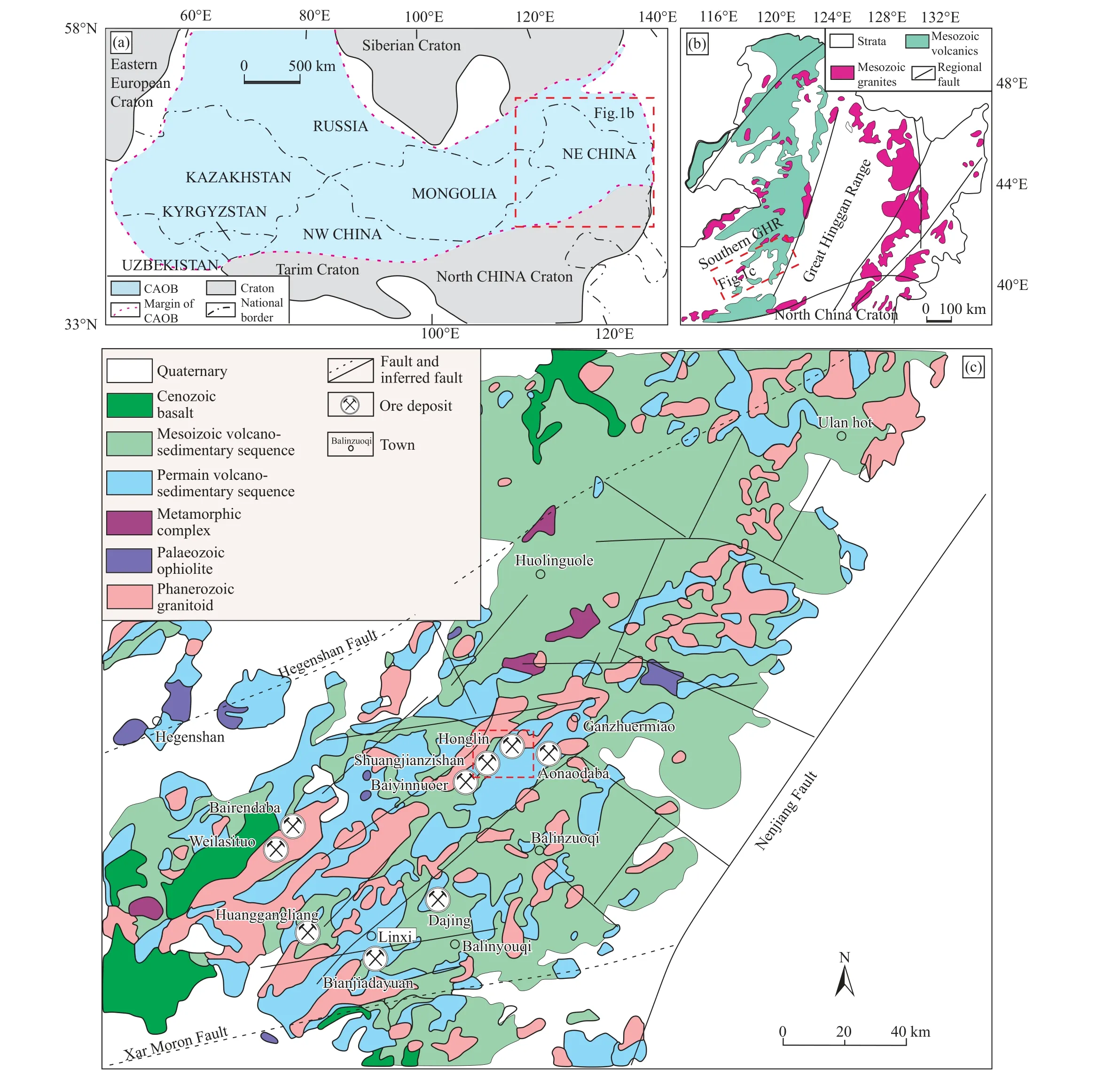
Fig.1.a-Tectonic scheme of the Central Asian orogenic belt (CAOB, modified from Jahn BM et al., 2000; Shen P et al., 2015); b-geologic map of the Great Hinggan Range (GHR) in northeast China showing the distribution of the Mesozoic granites and volcanic rocks (modified from Zhai DG et al., 2017); c-geologic map of the southern Great Hinggan Range showing the locations and timing of major ore deposits (modified from Ouyang HG et al., 2015).
The host rock is characterized by brecciated with silicification, choritization, epidotization, carbonatization,pyritization, and carbonate alteration (Zhai DG et al., 2019a,2019b).The silicification has a close relationship with the mineralization, which occurred on both sides of the ore veins(Fig.5).The ore minerals are native silver, eugenite,argentite, galena, sphalerite, pyrite, chalcopyrite, and marcasite, and they mainly occur in polymetallic quartz veins/veinlets and stockworks or dissemination around these veinlets (Kuang YS et al., 2014).The silver in ores occurs mainly as independent silver minerals (native silver minerals and eugenite) around sulfides or in disulfide cracks (Kuang YS et al., 2014; Zheng GR et al., 2015).Quartz and calcite are the major gangue minerals, along with minor amounts of sericite.
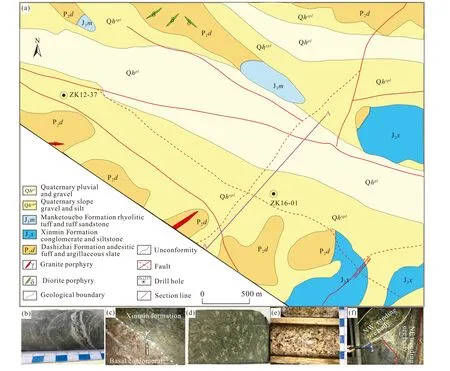
Fig.2.a-Map of the SJZ Ag-Pb-Zn deposit (modified from Zheng GR et al., 2015①Zheng GR, Zhang SJ, Liu DY.2015.The supplementary prospecting report of the Shuangjianzishan Ag-Pb deposit, Balinzuoqi, Inner Mongolia (unpublished technical report).Tiantong Geological Exploration Company, Chifeng City, Inner Mongolia, 1-96 (in Chinese).); b-Dashizhai Formation slate; c-unconformity interface between the Xinmin Formation and the Dashizhai Formation; d-coarse-grained porphyritic syenogranite; e-NE- and NW- trending ore bodies.
The mineralization is generally massive veins/veinlets and stockworks or disseminations, with some breccia textures.Sulfides precipitated later than quartz and filled in the vugs and interstices of the quartz, leading to the sulfides forming massive structures in the quartz veins (Fig.4).Under polarized light, the zonal textures have been observed in the sphalerite crystals, which is charactered by brown coloration in the core and bright yellow at the rim (Fig.4).Those zonal textures are interpreted to the inhomogeneous composition of the ore-forming fluid during crystallization (Cook NJ et al.,2009; Ye L et al., 2011).The micro-veined and disseminated chalcopyrite was observed in double-crystal joints and cracks of sphalerite (Fig.4), which have significant differences with vermicular chalcopyrite inclusions in sphalerite (Barton PB and Bethke PM, 1987; Eldridge CS et al., 1988).Thus, these textures were generated by replacement, but exsolution.The silver minerals occur as intergrowths with galena and sphalerite (Fig.4).
Three stages of the mineralization in the SJZ have been identified by the extensive observation of the mineralogical associations and mineral structure, which consists of the early-, main-, and late-ore stages.In the early-ore stage,euhedral pyrite (1-5 mm) formed in the roof of the ore bodies.In the main-ore stage, a complex polymetallic sulfide assemblage cocrystaled with quartz and calcite, and these sulfides are composed of black sphalerite, galena, silver minerals, and pyrite, which are characterized by coarsegrained and subhedral-euhedral textures (Fig.5).Sulfides infilled the residual vuggy porosity of earlier quartz generations, which resulted in the veins typically displaying drusy crystal growth and similar encrustations (Fig.5e).The late-ore stage is represented by fine-grained xenomorphic pyrite (0.01-0.10 mm), which occurs at the wall rock near the ore bodies (Fig.5f).

Fig.3.Prospecting line profile map of the SJZ Ag-Pb-Zn deposit (after Cai HA et al., 2021; Wang XD et al., 2018).
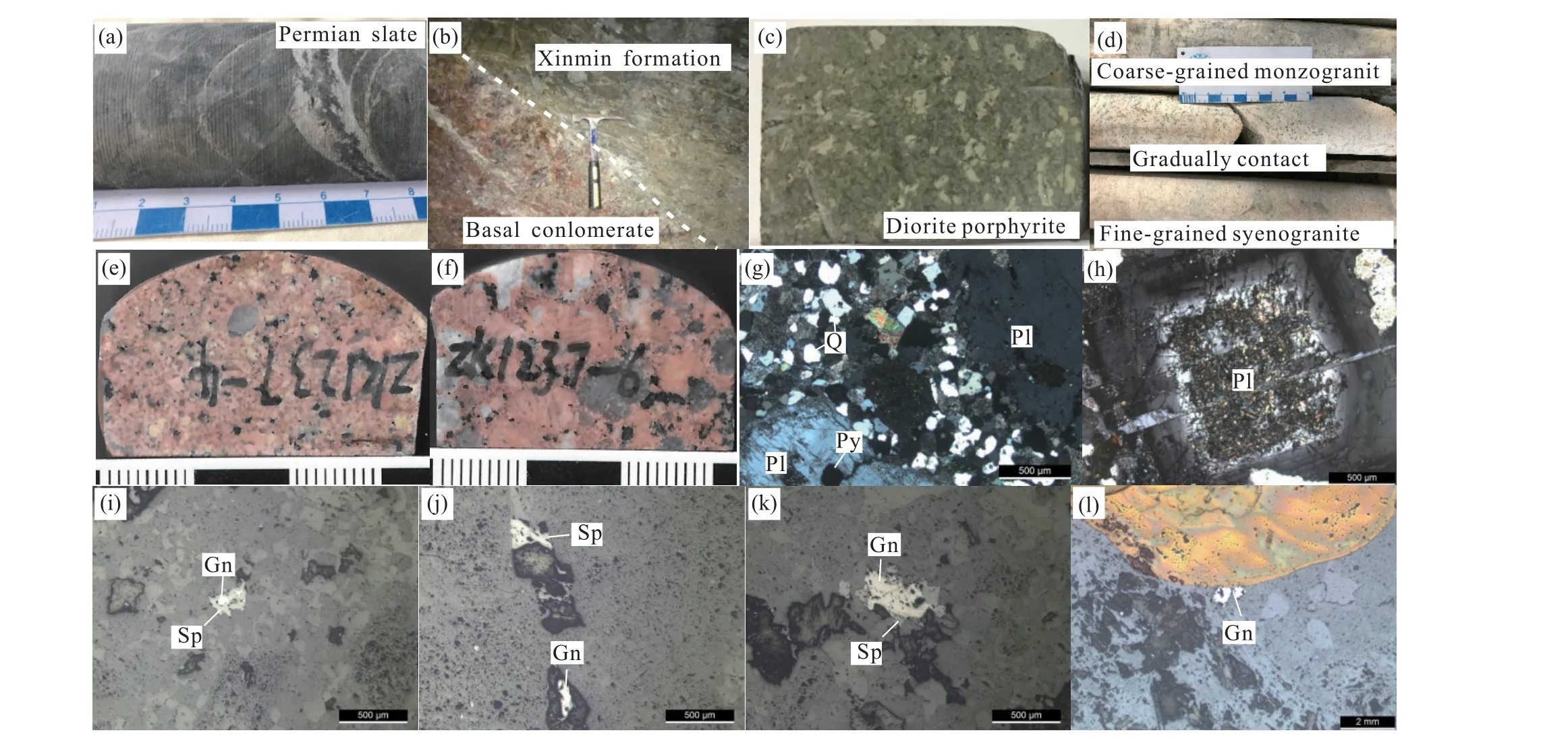
Fig.4.Representative rock samples from SJZ Ag-Pb-Zn deposit.a-Permian slate; b-Xinmin Formation (Jurassic dacite lava and rhyolitic tuff); c-diorite porphyrite; d-the contact relationship between the syenogranite and monzogranite; e-fine-grained syenogranite; f-coarsegrained monzogranite; g-Photomicrographs (in cross-polarized light) of the fine-grained syenogranite; h-plagioclase oscillatory zones in the coarse-grained monzogranite; i-l-micrograph of disseminated sulfides in the syenogranite.Pl-plagioclase; Q-quartze; Py-pyrite; Sp-sphalerite;Gn-galena.Fig.4d-f are modified from Dai M et al., 2022.
4.Samples and analytical methods
4.1. C, H, and O isotope analysis
The quartz samples collected from ore-bearing quartz-calcite veins/veinlets were crushed to about 60 mesh powders for hydrogen and oxygen isotope analyses, which were conducted at the Beijing Research Institute of Uranium Geology, Beijing.The measurements were performed using a Finnigan MAT253-type mass spectrometer following the methods used by Clayton, RN, and Mayeda, TK (1963).Oxygen gas was produced by reacting the samples with BrF5in externally heated nickel reaction vessels.Hydrogen was measured by reacting the H2O with zinc at 550°C.As the standard for reducing H and O, the results are based on the Standard Mean Ocean Water (SMOW) and their precision was within ±0.2‰ forδ18O and ±2‰ forδD.

Fig.5.Representative Pb-Zn-Ag ores and vein cutting relationships from the SJZ Ag-Pb-Zn deposit.a-hydrothermal breccia of host rock;b-c-hydrothermal breccia of host rock and early-ore-stage quartz vein in the breccia of host rock; d-quartz crystallized around breccia/fragments of hostrocks and with sulfides filling in the vug and interstitial to quartz, minor chalcopyrite grains distributed in sulfide veins; e-layers of comb-textured quartz and galena; f-late-ore stage fine-grained xenomorphic pyrite and late-ore-stage calcite vein; g-h-zoned texture of sphalerite; i-chalcopyrite and sphalerite replacing galena and pyrite, and chalcopyrite veins fill in the fracture of sphalerite; j-vein-like chalcopyrite distributed in the sphalerite fracture; k-galena replacing pyrite; l-late-ore stage pyrite; m-sphalerite replacing chalcopyrite and galena,and galena intergrown with polybasite and freibergite; n-pyrargyrite occurs as intergrowths with galena; o-canfieldite and polybasite gains grown in the fissure between sphalerite and galena grains.Photomicrographs g-h were taken under transmitted plane-polarized light; i-l were taken under reflected plane-polarized light.Ccp-chalcopyrite; Gn-galena; Py-pyrite; Sp-sphalerite; Caf-canfieldite; Frb-freibergite;Pyr-pyrargyrite; Pol-polybasite; Q-quartz; Cal-calcite.
The calcite samples collected from ore-bearing quartz-calcite veins/veinlets were crushed to about 200 mesh powders for carbon and oxygen isotope analyses, which were conducted by the Beijing Geoanalysis Company, Beijing.Using a Micromass MultiPrep preparation device interfaced with a dual-inlet Micromass Isoprime stable-isotope-ratio mass spectrometer, it adopted the phosphoric acid reaction method of Liu HB et al.(2013) but performed the reaction at 90°C.The carbon isotopic compositions are reported in delta notation (δ13C) relative to the international reference standard for carbon isotopes, i.e., VPDB and the oxygen isotopic compositions are reported in delta notation (δ18O) relative to the VPDB and VSMOW.The precision of the analyses was better than ±0.2‰.
4.2. He-Ar isotope analysis
Test analysis of the He-Ar isotope has been conducted by a MI- 1201IG inert gas mass spectrometer at the Institute of Mineral Resources, Chinese Academy of Geological Sciences(CAGS).Analytical methods are similar to Kendrick MA and Burnard P (2013).Approximately 200-1000 mg of 0.5-1.0 mm grains were loaded into vacuum crushers and atmospheric gases have been removed by baking on-line at less than 150°C for more than 24 hours.Gases were released from the grains into the all metal extraction system by sequential crushing in modified Nupro type valves.The released gases were exposed to a titanium sponge furnace at 800°C for 20 mins to remove the bulk of active gases (i.e., H2O and CO2), and then exposed to two SAES Zr-Al getters (one at room temperature, the other at 450°C) for 10 mins for further purification.Helium was separated from argon using an activated charcoal cold finger at liquid N2temperature (-196°C) for 40-60 mins to trap argon.Gas abundances were measured by peak-height comparison with known amounts of standard air from an air bottle.Procedural blanks were < 2×10-10cm3STP4He and 2×10-10-4×10-10cm3STP40Ar and constituted<1% of analyzed samples.The blanks were too low to affect the calibration of the abundance measurements.
4.3. In-situ S and Pb isotope analysis
Allin-situisotope samples were collected from different mining levels (+350 m to +200 m).The authors performed mineralogical observations of 22 polished thin sections of sulfide ore and selected seven polished thin sections (massive and veinlet ores) representing three mineralization stages at the SJZ Ag-Pb-Zn deposit forin-situsulfur isotope analysis and three polished thin sections (veinlets ores) forin-situlead isotope analysis.
The authors performedin-situsulfur isotopic analyses of sphalerite, galena, pyrite, and chalcopyrite using a Nu Plasma 1700 MC-ICP-MS (Nu instruments, UK), and used an NWR UP Femto (Electro Scientific Industries, Inc., USA)femtosecond laser ablation system as the ablation source forin-situanalysis at the State Key Laboratory of Continental Dynamics, Northwest University, Xian, China.
The NWR UP Femto femtosecond laser ablation system consists of a Quantronix Ti: Sapphire femtosecond laser amplifier Integra-HE and an ESI NWR Femto laser ablation system.The laser ultraviolet wavelength was 266 nm, which is the third harmonic of 800 nm, and its pulse duration was less than 130 fs.This instrument is equipped with a twovolume chamber with a large sample chamber (5000 cm3) and a high-sensitivity sample cell (1.6 cm3).The Nu 1700 MCICP-MS is equipped with 16 Faraday cups and three ion counters.The cup configurations for sulfur were an H5 cup for 34S, an Ax cup for 33S, and an L4 cup for 32S.Serious interference occurred from molecular ions, especially oxygen species, which were mixed with the sulfur peaks.The data acquisition type was static and the signal-analysis protocol included 30 cycles with an 8-s integration time per cycle.Two vials of pure water were used as the washer, with a total washing time of 140 s.Details regarding the fs-LAMCICPMSin-situS isotope analysis and instrument parameters are available in papers by Bao ZA et al.(2016a,2016b) and Chen L et al.(2016).
The authors conductedin-situlead isotope analyses of galena on 50 μm to 100 μm-thick polished sections, using a Nu Plasma™ multi-collector ICPMS with a femtosecond laser ablation system (NWR UPFemto, ESI, USA) (fLA-MCICPMS) at the State Key Laboratory of Continental Dynamics, Northwest University, Xian, China.The surfaces of the polished thin sections were cleaned using Milli-Q (18.2 MΩ cm) water before analysis.It then performed line-scan ablation, which consisted of background collection for 20 s followed by 50 s of laser ablation for signal collection.The laser ablation parameters are as follows: Spot size, 15 μm;100% output energy, >600 μJ; 100% energy density, 6 J/cm2;laser frequency, 5 Hz to 50 Hz; and ablation line rate, 3 μm/s,which ensures a strong enough Pb signal for the analysis of galena.The Tl (20 × 10-9, NISTSRM 997, 205Tl/203Tl =2.38890) and NIST SRM 610 glass served as internal and external standards, respectively.Repeated analyses of the NIST SRM 610 glass standard yielded highly reliable and reproducible results throughout the analytical process, with the means206Pb/204Pb = 17.052 ± 0.003,207Pb/204Pb = 15.515 ±0.003, and208Pb/204Pb = 36.980 ± 0.007 (1s, n = 183).Details regarding fs-LA-MCICPMSin-situPb isotope analysis and the instrument parameters are available in the works of Yuan HL et al.(2015) and Bao ZA et al.(2016).
4.4. Bulk Pb isotope analysis
The authors collected two diorite porphyrite and five Dashizhai Formation slate samples from underground mining tunnels and drill holes for bulk Pb isotope analysis.Fig.4 shows the locations of these samples.
The fresh diorite porphyrite shows a gray-green color and a porphyritic structure (Fig.4c).Phenocrysts (ca.35 vol.%) in the diorite porphyry are plagioclase ca.20 vol.% (1-2 mm)(Fig.4c) and amphibole ca.10 vol.% (1 mm) with minor biotite ca.5 vol.% (0.5 mm).The matrix consists of plagioclase ca.60 vol.% (0.1-0.2 mm), amphibole ca.35 vol.% (0.05-0.10 mm) with minor biotite ca.5 vol.% (ca.0.05 mm), and disseminated pyrite, sphalerite, and galena mineralizations.
Pb isotopic composition measurements were performed on a Nu II MC-ICP-MS Instrument (Nu Instrument, Wrexham,UK) at the State Key Laboratory of Continental Dynamics,Northwest University, Xi’an, and the Beijing Geoanalysis Company.During the analyses, L4, L3, L2, L1, Ax, H1, and H2 Faraday cups were used to collect the202Hg,203Tl,204Hg+204Pb,205Tl,206Pb,207Pb, and208Pb ion beams,respectively.The solution was self-aspirated at an uptake rate of 100 μL/mi through a standard PFA nebulizer and then desolvated by the AridusTM.The solution standards of the NIST NBS-981 adopted with NIST NBS-997 were measured along with the samples during the same MC-ICP-MS runs.The data were corrected for mass fractionation by normalizing them to205Tl/203Tl=2.3889 using an exponential law.The Pb isotope analyses consist of two blocks with 20 cycles per block and an integration time of 10 s per cycle.The wash-out time (180 s) and time for transfer sample (120 s) resulted in an average instrument time of 12 mins per data.In this study,the measured NBS-981values agreed well with the recommended values of208Pb/206Pb = 2.1674 ± 0.0005,207Pb/206Pb = 0.91486 ± 0.00025,206Pb/204Pb = 16.9397 ±0.0111,207Pb/204Pb = 15.4974 ± 0.0089, and208Pb/204Pb =36.7147 ± 0.0262, as recommended by Yuan HL et al.(2016).Finally, the Pb isotopic ratios were accurately determined after correction and were normalized to the SRM 981.
5.Analytical results
5.1. C, H, and O isotope analyses
Table 1 lists the hydrogen and oxygen isotope data, which are also shown in Fig.6.The measuredδ18O values of five representative quartz samples and two calcite samples from different mineralization stages range from 6.3‰ to 16.2‰.The calculatedδ18OH2Ovalues from the early-ore to late-ore stages range from 7.7‰ to 9.1‰, from 7.5‰ to 7.9‰, and 1.8‰ to 3.8‰, respectively.TheδD values of the FIs in the hydrothermal quartz samples ranged from -119‰ to -69‰,with an average of -98‰.
Table 2 and Fig.7 show the C-O isotopic composition of calcite.The samples from ore-bearing calcite veins were measured to haveδ13C values ranging from -11.7‰ to-8.1‰ (mean = -9.9 ‰) (Fig.7), which are within the typical range of mantle CO2(Clark I and Fritz P, 1997).Theδ18O values for the ore-calcite samples ranged from -3.5‰ to 3.2‰ (mean = 0.5333‰) (Table 2; Fig.7).
5.2. He-Ar isotope
Noble gas abundance and isotopic data are listed in Table 3.The analytical results show that40Ar and4He concentrations range from 150×10-9ccSTP/g to 470 ×10-9ccSTP/g and 40×10-9ccSTP/g to 90×10-9ccSTP/g, respectively.Measured40Ar/36Ar ratios range from 306.3 to 321.1.The36Ar/38Ar ratios of fluid inclusions in all analyzed samples are relatively uniform and show a narrow range of 0.165-0.187 with an average of 0.179.The3He/4He ratios of fluid inclusions hosted in sulfides are mainly from 0.33 to 0.78 Ra with an average of 0.54 Ra, where Ra represents the3He/4He ratios of the atmosphere with a value of 1.4×10-6(Mamyrin BA and Tolstikhin LN, 1984).The value of4HeMantleis 5.4 % to 12.8 %,and the value of F4He is a range of 160.5-763.0 (Fig.8).

Table 1.H and O isotope compositions of the ore fluids in the SJZ Ag-Pb-Zn deposit.
5.3. In-situ S and Pb isotopes
Table 4 lists thein-situS isotopic compositions of the sulfide samples.Theδ34S values of the early-ore stage pyrite grains range from -2.3‰ to 0.2‰ (10 analyses) (Figs.9a,10a; Table 4), which are comparable to the main-ore stages of sphalerite (-2.5‰ to +0.5‰; 15 analyses), chalcopyrite(-1.5‰ to 0.1‰; 10 analyses), galena (-2.7‰ to -1.4‰; 11 analyses), and pyrite (-3.0‰ to -0.7‰; 10 analyses)(Figs.9b, 10b).Theδ34S values of the post-ore pyrite grains range from -0.3‰ to 2.3‰ (seven analyses; Figs.9c, 10c; Table 4).Theδ34S values of the syenogranite sulfide grains range from-1.1‰ to 0.5‰ (eight analyses; Figs.9d, 10d; Table 4).
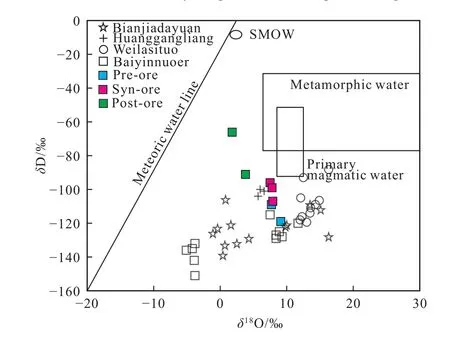
Fig.6.δD vs.δ18O diagram of the ore-forming fluids in the SJZ Ag-Pb-Zn deposit.Isotopic compositions of magmatic and metamorphic waters after Taylor HP (1974), and meteoric water line after Craig H (1961).Coeval deposit D-O isotope compositions after Mei W et al., 2015; Ouyang GH et al., 2014, 2015.
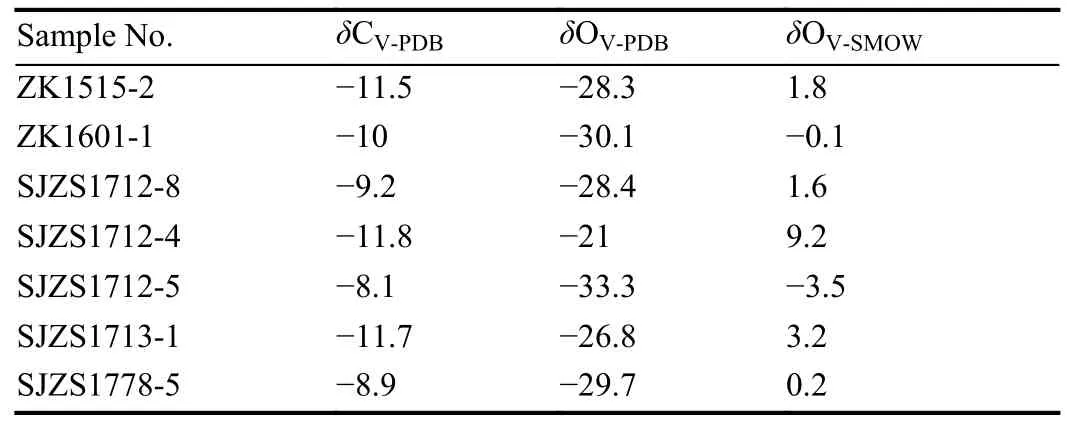
Table 2.C and O isotope compositions of calcites in the SJZ Ag-Pb-Zn deposit (‰).
Table 5 lists thein-situlead isotopic compositions of galena.The206Pb/204Pb,208Pb/204Pb, and207Pb/204Pb ratios of the galena grains in the ZK1601-2 sample range from 18.291 to 18.295 (average of 18.292), 38.148 to 38.162 (average of 38.153), and 15.545 to 15.550 (average of 15.547),respectively (Figs.9a, 11; Table 5).The206Pb/204Pb,208Pb/204Pb, and207Pb/204Pb ratios of the galena grains in the ZK1601-14 sample range from 18.291 to 18.299 (average of 18.294), 38.143 to 38.167 (average of 38.159), and 15.544 to 15.553 (average of 15.549), respectively (Figs.9b, 11; Table 5).The206Pb/204Pb,208Pb/204Pb, and207Pb/204Pb ratios of the galena grains in the ZK1601-3 sample range from 18.288 to 18.296 (average of 18.290), 38.143 to 38.167 (average of 38.157), and 15.544 to 15.553 (average of 15.545),respectively (Figs.9c, 11; Table5).The206Pb/204Pb,208Pb/204Pb, and207Pb/204Pb ratios of the galena grains in the ZK1237-2 sample range from 18.301 to 18.309 (average of 18.305), 38.153 to 38.171 (average of 38.162), and 15.544 to 15.550 (average of 15.547), respectively (Figs.9d, 11; Table 5).
5.4. Bulk Pb isotope analysis
Table 5 lists the bulk Pb isotope compositions of slate,syenogranite, and diorite porphyrite.The206Pb/204Pb,208Pb/204Pb, and207Pb/204Pb ratios of the syenogranite samples range from 18.844 to 19.009 (average of 18.834),38.571 to 38.785 (average of 38.641), and 15.573 to 15.588(average of 15.578), respectively (Fig.11; Table 5).The206Pb/204Pb,208Pb/204Pb, and207Pb/204Pb ratios of the diorite porphyry samples range from 18.285 to 18.323 (average of 18.299), 38.149 to 38.224 (average of 38.179), and 15.541 to 15.55 (average of 15.545), respectively.The206Pb/204Pb,208Pb/204Pb, and207Pb/204Pb ratios of the slate samples range from 18.279 to 18.288 (average of 18.284), 38.112 to 38.120(average of 38.116), and 15.308 to 15.535 (average of 15.533), respectively (Fig.11; Table 5).
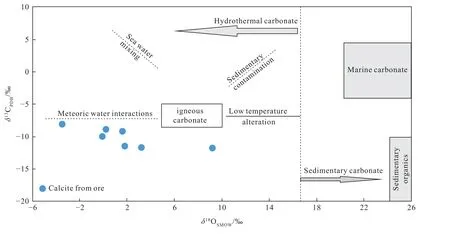
Fig.7.δ13CPDB vs.δ18OSMOW diagram of the calcite in the SJZ Ag-Pb-Zn deposit (after Liu YF et al., 2017).

Table 3.He and Ar isotope compositions of sphalerite in the SJZ Ag-Pb-Zn deposit.

Fig.8.3He/4He vs.40Ar/36Ar diagram (a), and 3He/4He vs.40Ar*/4He (b) of fluid inclusions in sphalerite from the SJZ Ag-Pb-Zn deposit.
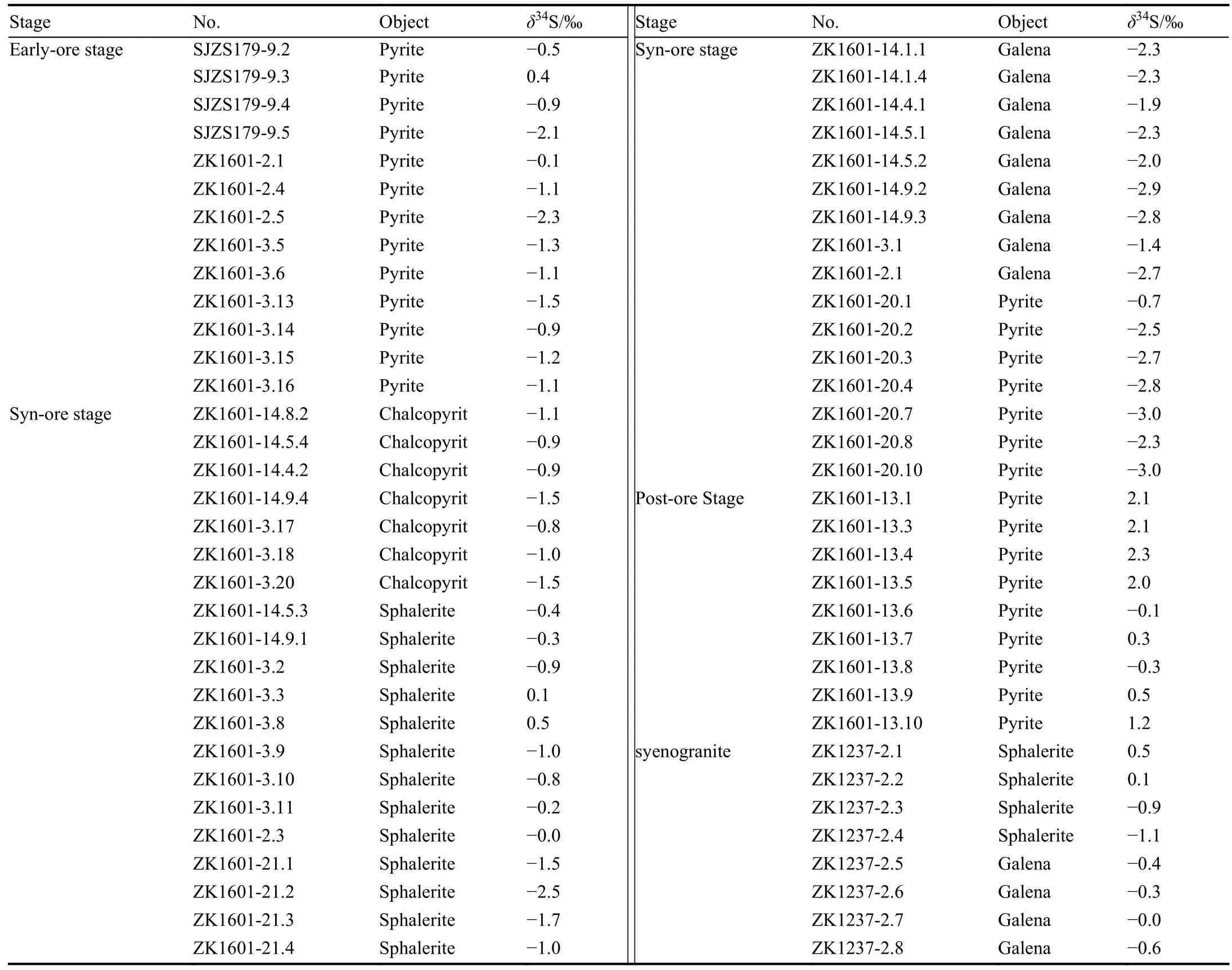
Table 4.Sulfur isotopic compositions of sulfides in the SJZ Ag-Pb-Zn deposit.

Fig.9.Photomicrographs in reflected light showing the location of in-situ S and Pb isotope values of pyrite, galena, and sphalerite.a-pre-ores stage pyrite; b-syn-ore stage sphalerite, chalcopyrite, galena, and pyrite; c-post-ore pyrite; d-The syenogranite.Py-pyrite; Sp-sphalerite;Gn-galena; Ccp-chalcopyrite.
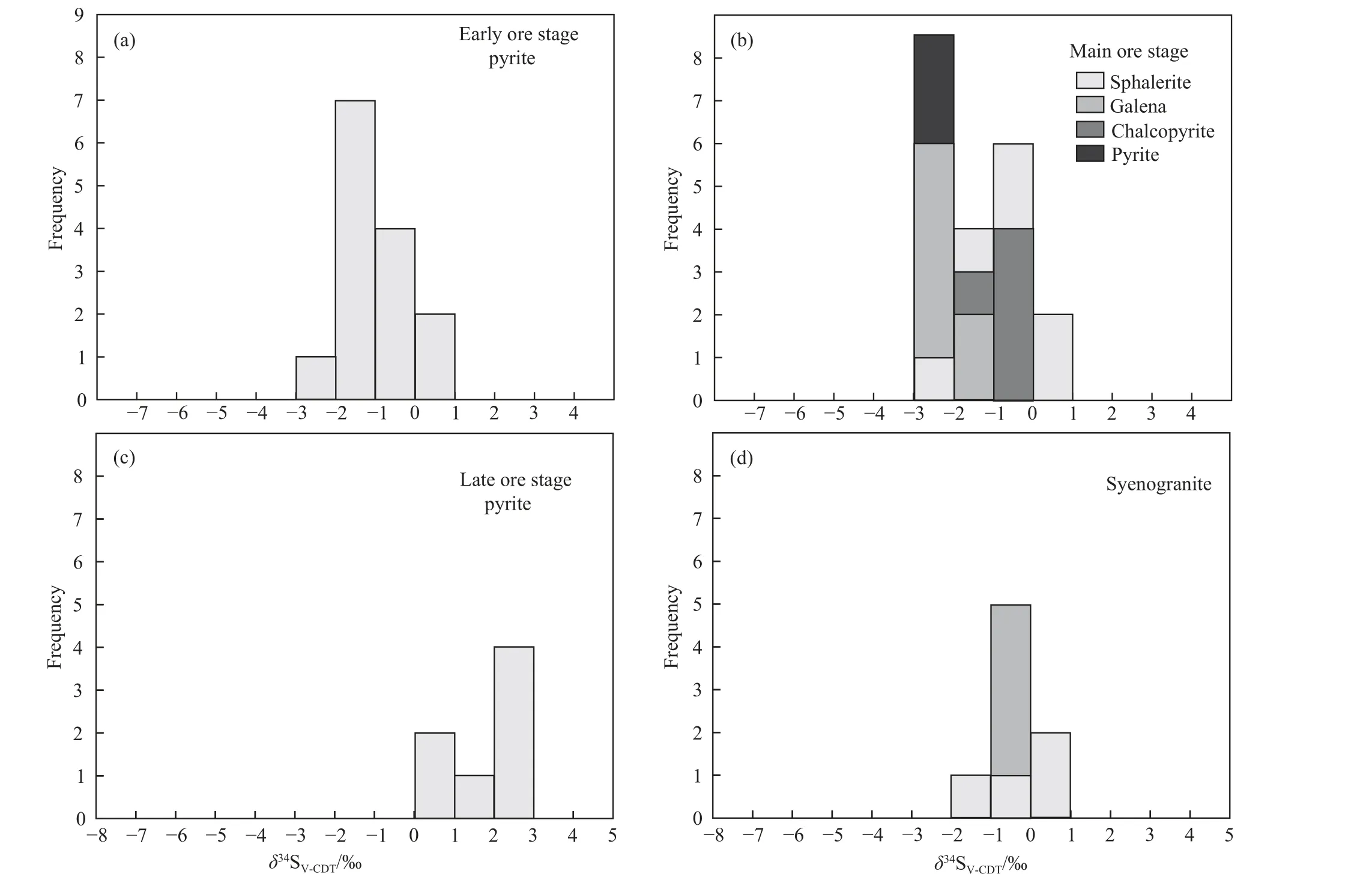
Fig.10.The δ34S of representative sulfide in the different ore stages and syenogranite.
6.Discussion
6.1. Sources of ore-forming fluids
Previous studies suggest that the combined application of multiple isotopic analyses is an effective way to trace the sources of ore-forming fluids (Zhai DG et al., 2018a, 2020).
The SJZ ore-bearing quartz and calcite veins have relatively highδ18OH2Ovalues (7.5‰ to 9.1‰ and 1.8‰ to 3.8‰, respectively), which is consistent with those reported in other magmatic-hydrothermal deposits in the SGHR (Ouyang HG et al., 2014, Zhai DG et al., 2018a), suggesting a magmatic signature (Cooke DR et al., 2011) (Fig.6).In contrast, they have lowδDH2Ovalues ( -119‰ to -66.1‰).Zhai DG et al.(2018a) and Zhang HY et al.(2019) pointed out that lowδDH2Ovalues could be caused by fluid mixing between meteoric fluid and ore fluid.Combing with theδ18OH2Ovalues of these samples showing a remarkable decline from the early to late stage (Fig.6), the authors infer that the SJZ ore-forming fluid was originated from magmatic water and diluted by meteoric water in the late-ore stage.
Theδ13C values of the SJZ post-ore stage calcite range from -11.7‰ to -8.1‰, which indicates a dominant magmatic origin for the carbon (-9‰ to -3‰, Taylor HP et al., 1967).Besides, such variation of theδ18O values (-3.5‰to 3.2‰), suggests meteoric water mixing (Fig.7).These C-O isotope features indicating that the SJZ late ore stage calciteveins precipitation from magmatic water with the mixing of the meteoric water.
The3He/4He ratios of fluid inclusions extracted from sphalerite show higher values (0.33-0.78 Ra) than the value of crust-derived He (0.01-0.05 Ra, Stuart FM et al., 1994).However, the obtained3He/4He ratios of sphalerite in the deposit are significantly lower than the value of mantlederived He (6-7 Ra).In the3He/4Hevs.40Ar/36Ar (Fig.8a)and40Ar*/4He (Fig.8b) plots, the noble gas isotopic data plotted between the mantle and crust field, suggesting a hybrid-He source.Besides, crust-mantle dual model: Hemantle(%) = (R-RC) / (RM-RC) × 100%, where RM= 8, RC= 0.01 andRrepresent the3He/4He ratios of the fluids in the mantle,crust, and the sample (Kendrick MA et al., 2001; Tolstikhin IN, 1978), the calculated results of the percentage of the mantle He from the SJZ Ag-Pb-Zn deposit are in the range of 5.4%-12.8%, with an average of 8.9%.These values indicate that the ore-forming fluids are dominated by crustal fluids with only a minor contribution from the mantle.The measured40Ar/36Ar values of fluid inclusions hosted in the SJZ sphalerite range from 306.3 to 320.9 (average 314.7),which are close to the value of the air-saturated water (295.5),but much lower than those of mantle and crust-derived Ar(Stuart FM et al.1994).In the3He/4Hevs.40Ar/36Ar diagram(Fig.8a), all data points plot in the field between the ASW and crustal end members.Therefore, the SJZ ore-forming fluids might be a mixture of crustal fluid and meteoric water.
In summary, the C-D-O-He-Ar isotope compositions indicate that the SJZ ore-forming fluids originated from a mixture source between crustal-derived magmatic-hydrothermal fluid and meteoric water.As mentioned above,disseminated sulfides have been observed in the syenogranite.Therefore, The authors infer that the SJZ ore-forming fluids originated from the syenogranite magmatic system.
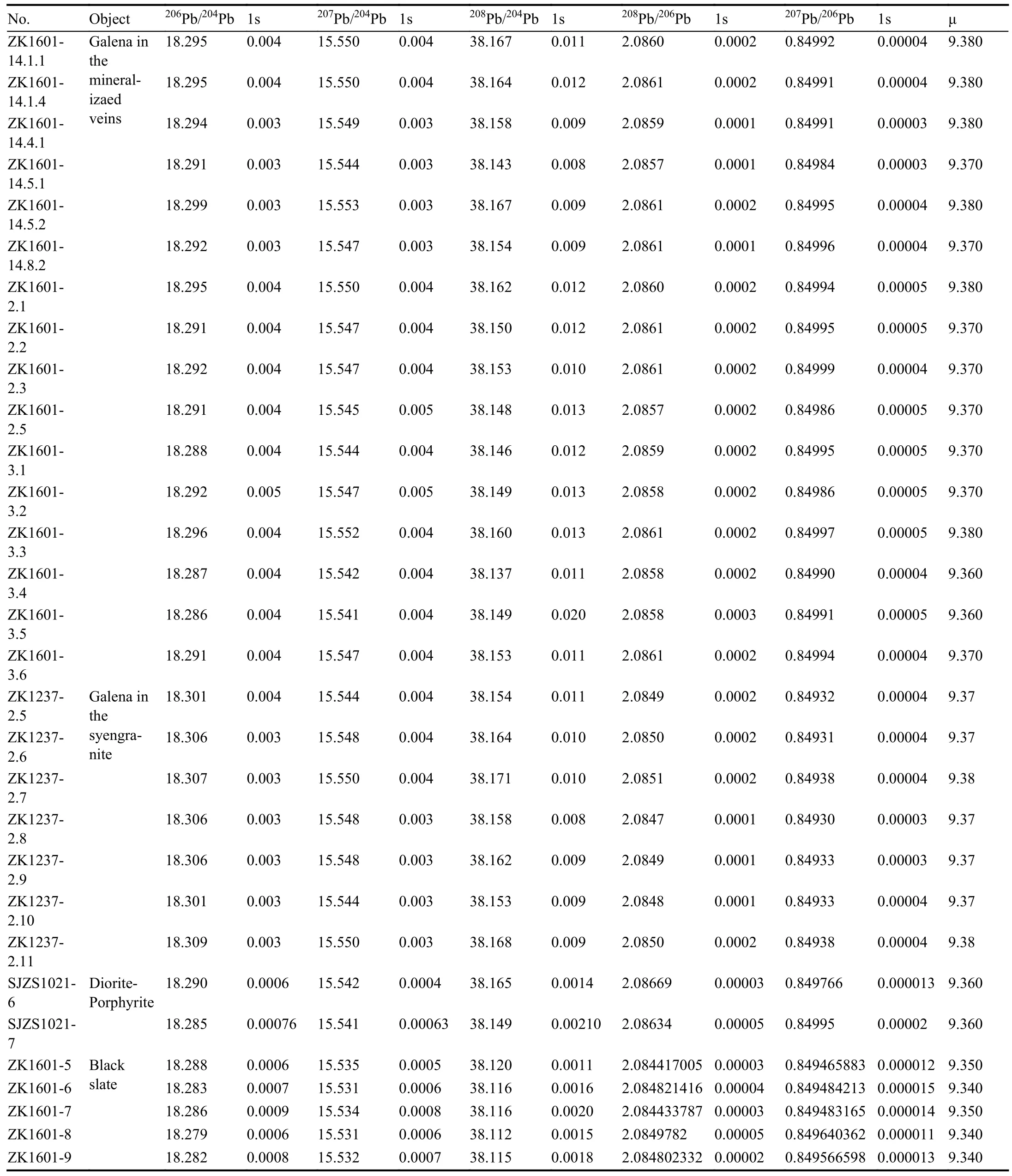
Table 5.Pb isotopic compositions of sulfides in the SJZ Ag-Pb-Zn deposit.
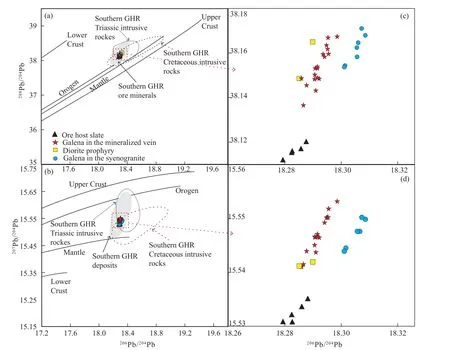
Fig.11.a-in-situ 208Pb/204Pb vs.206Pb/204Pb diagram; b-in-situ 207Pb/204Pb vs.206Pb/204Pb diagram; c-in-situ 208Pb/204Pb vs.206Pb/204Pb diagram that presents the comparison between in-situ and bulk Pb isotope data; d-in-situ 207Pb/204Pb vs.206Pb/204Pb diagram that presents the Pb evolution curves of galena and diorite porphyry.The shadow area represents the Pb isotope component from the Haobugao deposit, Baiyinnuoer deposit, Huanggangliang deposit, and Weilasituo deposit; the date from Jiang SH et al., 2010, 2011a, 2011b; Ouyang HG et al., 2014; Zhai DG et al., 2014; Liu LJ et al., 2018; the Triassic intrusive rocks data from Jiang SH et al., 2017; the Cretaceous intrusive rocks data from Jiang SH et al., 2017; Mei W et al., 2015; Ouyang HG et al., 2014; Zhai DG et al., 2014; the Upper Crust, Orogen, Mantle, Lower Crust Pb evolution lines from Zartman RE and Doe BR, 1981.
6.2. Sources of sulfur and metal
Ohmoto H and Rye R (1979) and Rollinson H (1993)pointed out that the sulfur isotope is an efficient way to decipher the source of ore-forming materials.Theδ34S values of sulfide samples (galena, sphalerite, and pyrite) in the SJZ Ag-Pb-Zn deposit, with a limited range from -3.0‰ to+2.3‰, mostly between -3.0‰ and 0‰.These sulfide samples with uniformδ34S values are consistent with the magmatic sulfur (Seal RR, 2006), which indicates a relatively constant physicochemical condition of the ore-forming fluids during ore precipitation.In-situS isotope analysis shows that most of the pyrite, chalcopyrite, and sphalerite grains are enriched inδ34S compared to galena in the main-ore-stage Ag-Pb-Zn veins (Table 4; Fig.10), which indicates that sulfides were in equilibrium with ore-forming fluids.A few samples have more negative or positive values, most likely resulting from local variations of temperature, redox conditions (ƒO2), and pH (Ohmoto H, 1972).Collectively,sulfides from the Baiyinnuoer, Haobugao, Bairendaba,Weilasituo, Huanggangliang, and Bianjiadayuan deposits in the SGHR haveδ34S values mostly in the range of -4‰ to 5‰ (Jiang SH et al., 2010, 2011a, b, 2017; Ouyang HG et al.,2014,2015), which is consistent with other porphyries-, skarnand hydrothermal- type deposits in the world (Meinert LD et al., 2005; Cooke DR et al., 2011).Therefore, theδ34S enrichment in the SJZ Ag-Pb-Zn deposit is interpreted to have a magmatic sulfur origin (Ohmoto H, 1972; Seal RR, 2006).
In the208Pb/204Pbvs.206Pb/204Pb diagram, the majority of Pb isotope values plot in the field between the lower crust and orogenic belt evolution line, and are closer to the orogenic belt evolution line (Fig.11a); Pb isotope values fall between the mantle and orogenic belt evolution line on the207Pb/204Pbvs.206Pb/204Pb diagrams.These features suggest the Pb was initially derived from the mantle and crustal mixture, with more affinity to crustal material.This view has been further proved by theμvalues of the SJZ sulfides, theμvalues range from 9.36 to 9.38, with an average of 9.37, which are lower than upper crustal values (9.58) but higher than mantle values(8.92; Doe BR and Zartman RE, 1979), these features further demonstrates that the Pb of the SJZ Ag-Pb-Zn deposits was originated from a mixture Pb source.Notably, the Pb isotopic compositions of galena from ore-veins are broadly comparable to values of the disseminated galena from finegrained syenogranite (Fig.11).Moreover, the galena Pb isotopic data points of the sulfides present a linear correlation with the host slate (Fig.11).The authors suggest that the finegrained syenogranite magma and the Dashizhai Formation slate contributed most of the lead and ore-forming metals(Figs.11a, b; Andrew A et al., 1984; Chiaradia M et al.,2006).
In summary, the Pb-S isotopic compositions of the SJZ sulfide are indicating that the SJZ ore-forming S and Pb generated from the crust-derived magma, which is consistent with most of the coeval ore deposits and intrusive rocks in the southern GHR (Ouyang HG et al., 2015, Zhai DG et al.,2019a).It is noteworthy that little proportion of metals from mantle-material has been observed (Fig 8, 11).
6.3. Causative intrusion
As mentioned above, three types of intrusive rocks have been exposed in the SJZ Ag-Pb-Zn deposit, that are diorite porphyrite, monzogranite, and syenogranite.The Ag-Pb-Zn mineralized veins crosscut the diorite porphyrite, and the diagenetic age of the diorite porphyrite (240.7 Ma) is significantly older than the Metallogenic age (135 Ma; Zhai DG et al., 2020).Besides, the monzogranite is a coarsegrained texture and is free of sulfides, and the zircon U-Pb age of monzogranite (142 Ma) is slightly older than the metallogenic age (Dai M et al., 2022).Previous studies pointed out that mineralization is usually a catastrophic event in the lithosphere, and the coarse-grained texture suggests magma underwent sufficient crystallization and homogenization, which is disadvantageous to the ore-forming elements enriching (Dai M et al., 2019; Luo ZH et al., 2010).According to the field investigation, petrographic observation,and the stable isotopic composition characteristics of the syenogranite, the authors infer that the mineralization of the SJZ Ag-Pb-Zn deposit has a close relationship with the syenogranite magmatic system.Therefore, the authors suggest that the syenogranite is the ore-forming intrusive rock in the SJZ Ag-Pb-Zn deposit.
First, the zircon U-Pb isotopic age of the monzogranite is 142 Ma (Dai M et al., 2022), which is slightly older than the syenogranite (140 Ma; Dai M et al., 2022), suggesting the syenogranite is not chilled margin part of the monzogranite.Moreover, the diagenetic age of the syenogranite is 135-140 Ma (Dai M et al., 2022, Zhai DG et al., 2020), which is consistent with the molybdenite and pyrite Re-Os isotopic model ages (135 Ma; Zhai DG et al., 2020).Second, the disseminated galena, sphalerite, and molybdenite have been observed in syenogranite (Fig.4), and there is a cotectic texture between the sulfides and the quartz/feldspar in syenogranite, which suggesting they crystallized at the same time.Third, the disseminated sulfides in the syenogranite have comparable S-Pb isotopic composition with sulfides in the mineralized veins (Fig.10, 11).Fourth, the have low Mg#,near zero whole-rock Nd isotopic compositions, positive zircon Hf isotopic compositions and juvenile TDM2ages(761-1091 Ma and 589-994 Ma), which suggest the primary magma of the syenogranite was derived from partial melting of the juvenile lower-crustal basaltic rocks (Dai M et al.,2022).
6.4. Evidence of crystal accumulation and high-silicic melt extraction
The syenogranite is charactered by higher SiO2(> 75%)and K2O contents and lower MgO, TiO2,and P2O5concentrations than the monzogranite (Fig.12; Table.6),implying the syenogranite is the most evolved magmatic rocks.Although, the syenogranite and monzogranite have a gradually contact relationship and the same Sr-Nd-Hf isotopic compositions, they have different solidification processes.
The syenogranite and monzogranite show tight linear trends on the Harker diagram (Fig.12).The monzogranite samples show relatively weak Eu negative anomaly (Eu=0.29-0.41) and have relatively high CaO, TFe2O3, Mg, Al2O3,Ba and Sr contents and low K2O and Rb concentrations (Figs.12, 13), which could be interpreted by the deeper magma reservoir that had accumulated plagioclase, biotite, and Ti-Fe oxides.The incorporation of around 38% plagioclase and/or biotite is sufficient to raise the Sr content of the rock from about 140×10-6-300×10-6and the Eu content of the rock from 0.4×10-6to 0.8×10-6(Fig.14) (see modeling discussion below).Abundant petrographic evidence demonstrates that the SJZ monzogranite has solidified largely through the accumulation of crystals in the magma reservoir (Fig.14).Such as the aggregates of coarse-grained euhedral plagioclase crystals and aggregates of biotite crystals have been observed in the monzogranite, which is consistent with the physical accumulation of crystals (Vernon RH and Collins WJ, 2011).In addition, a framework of touching euhedral minerals dominated by plagioclase and alkali feldspar along with minor biotite and hornblende is interpreted by the cumulation of the earlier-formed euhedral minerals (Schaen AJ et al., 2018).The cores of plagioclase crystals have variable zonation histories (Fig.4h), which suggests that they crystallized in different environments and accumulated together later before the crystallization of their rims (Beane R and Wiebe RA,2012).Thus, according to these petrographic observations and the geochemical characteristics of the whole rocks, the monzogranite is interpreted to represent the cumulate residue of a crystal mush (or magma reservoir).
The fine-grained syenogranite has higher SiO2, K2O contents, and differentiation index (DI>92), lower Al2O3and other major elements than the coarse-grained monzogranite(Fig.12), and plot in the opposite direction of fractional crystallization to the coarse-grained monzogranite (Fig.15),indicating accumulations of plagioclase were left behind during the formation of the fine-grained syenogranite (Sisson TW, 1994).The fine-grained syenogranite has positive Rb and negative Sr and Eu anomalies, which also support crystal fractionation of plagioclase (Fig.14).The decreasing Fe2O3contents are most likely the results of magnetite fractionation(Fig.12).Moreover, the fine-grained syenogranite show the Zr/Hf ratios have a negative correlation withδEu values, and the La/Yb and Gd/Yb ratios decrease with the Rb/Sr ratio increase, along with decreasing TiO2, CaO and P2O5contents,which suggest LREE-rich minerals fractional crystallization(apatite, titanite, and monazite) (Fig.15).Furthermore, both the fine-grained syenogranite and coarse-grained monzogranite samples show an obvious genetic relationshipin the Rayleigh fractionation model (Fig.14).A starting composition plotted within the Rb, Sr, and Eu contents gap was chosen to bracket the range of initial trace element concentrations of the coarse-grained monzogranite and the fine-grained syenogranite.In the Rayleigh fractionation model, the most coarse-grained monzogranite are plotted into the cumulate residual field, and all fine-grained syenogranite within the extracted melts zone (Fig.13).Therefore, these geochemical characteristics indicate that parental magma of the fine-grained syenogranite is extracted from a monzogranite crystal mush (monzogranite).
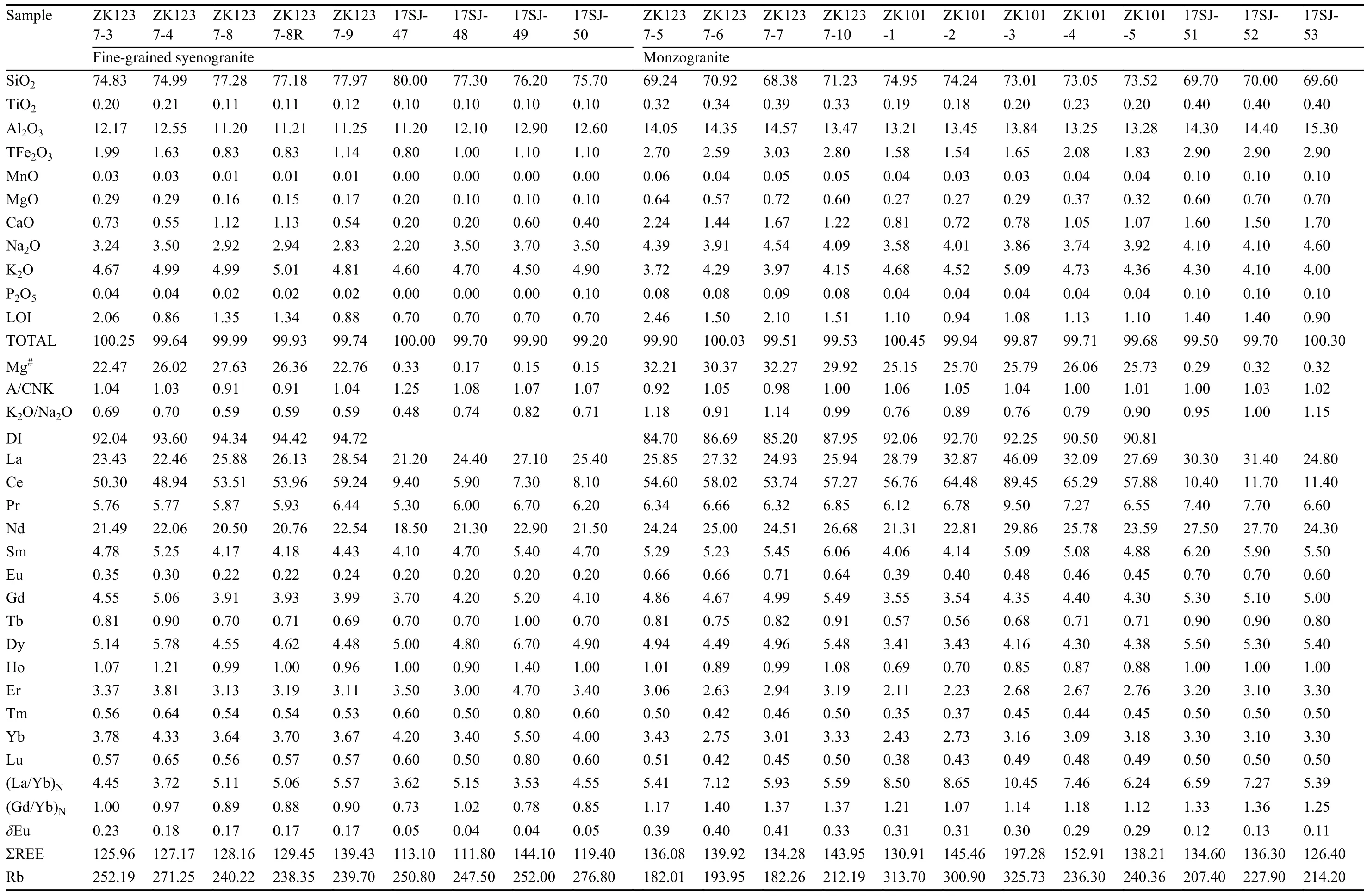
Table 6.Major element (%) and trace element (10-6) concentrations of syenogranite and monzogranite in the SJZ Ag-Pb-Zn deposit.

Table 6.(Continued).
6.5. Implications for melt extraction and mineralization
As discussed above, the diagenesis of the syenogranite has a close relationship with the ore-forming fluid in the SJZ Ag-Pb-Zn deposit, and the syenogranite was residual melts extracted from the monzogranite crystal mush.Thus, the oreforming fluid/material originated from the parent magma which the syenogranite and the monzogranite derived.The Sr-Nd-Hf isotopic compositions of the syenogranite and the monzogranite, suggest they originated from partial melting of the juvenile lower-crustal basaltic rocks (Dai M et al., 2022;Ruan BX et al., 2015).Combing with the absence of coeval mafic magmatism rock in the SGHR and most microgranular enclaves (MEs) in the Early Cretaceous granitoids are charactered by high SiO2(56.16%-63.70%) content and low Mg#value (27.72-39.87) (Dai M et al., 2022, Wei W et al.,2020), implying mantle material was not involved in the Early Cretaceous magmatism.Thus, the mantle characters of the SJZ sulfides He-Pb isotopic compositions could be originated from the juvenile lower-crustal basaltic rocks.Ouyang HG et al.(2015) suggested that the upwelling asthenosphere triggered the SGHR Early Cretaceous granitic magmatism.The upwelling asthenosphere heats the lower crust material,which is leading to the large-scale dehydration melting of lower crust materials and the dehydration of lower crust material would generate a large amount of fluid (gas-liquid phase) (Zhang Q, 2012).The metal elements could be extracted by those fluids from the lower crust materials because these fluids have relatively high activity and the metal elements have a low value of Dmelt/fluidand Dcrystal/fluid(Luo ZH et al., 2011).
The mixing/mingling between the fluids and the intermediate-acid magma of the monzogranite would greatly increase the fluidity of the intermediate-acid magma (Luo ZH et al., 2010).Then, these fertilized fluids mixing/mingling with the parent magma of the monzogranite and underplating to the upper crust.The monzogranite is a coarse-grained structure, indicating the monzogranite magma underwent cooling crystallization and homogenization, then formed an inactive crystal mush.These fertilized fluids were trapped in the intergranular melt, which is an unfavorable condition for mineralization (Luo ZH et al., 2010, 2014, Zhang SH, 2011).
The MEs have been observed in the monzogranite and the MEs have similar zircon U-Pb age and Hf isotopic with the monzogranite (Dai M et al., 2022), implying that the magma recharge has triggered the melt extraction and crystal-melt segregation processes in the SJZ Ag-Pb-Zn deposit.The injected less-felsic magmas from deeper crustal levels are typically hotter than the shallow silicic crystal mush they intrude, which can provide very large amounts of thermal energy to decrease magma viscosity (Luo ZH et al., 2014).Furthermore, the fluids also have been recharged from deeper magma reservoirs.Then, the fertilized fluids and intergranular melt (syenogranite magma) are extracted from the crystal mush and emplaced in the shallow.The melt extraction further concentrated the fertilized fluids, which were dispersed in the magma chamber.Because P-T conditions sharply changed in the shallow, the syenogranite magma rapid cooling crystallization and decoupled with the fertilized fluids.The fertilized fluids mixed with meteoric waters,which led to the mineralization in the SJZ Ag-Pb-Zn deposit.

Fig.13.Co-variations of element concentrations and elemental ratios of the fine-grained syengranite and coarse-grained monzogranite.a-Ba vs.Sr; b-dEu vs.SiO2 ; c-dEu vs.Sr; and d-Rb vs.Sr.The symbols are the same as in Fig.12.

Fig.14.Trace element modeling obtained using Sr vs.Rb (a) and Eu vs.Rb (b) diagrams.Fractionating mineral assemblage resembles that in the Shuangjianzishan monzogranite.Starting compositions (Rb=240×10-6; Sr=100×10-6; Eu=0.35×10-6) have been considered to plot within the compositional gap (see text for further information).Complementary fractional crystallization models use the same starting composition tracking evolution of melt, and the cumulate crystallized from that melt.Partition coefficients have been estimated based on the assumed mineral proportions of the Shuangjianzishan monzogranite (25% quartz, 38% plagioclase, 30% alkali-feldspar, 5% biotite, 1% hornblende, 1% accessory minerals).Symbols and numbers along the lines indicate melt fraction (F).High and low partition coefficients have been tested (Appendix S1).Partition coefficients are listed in Appendix S1.Symbols are the same as in Fig.12.

Fig.15.Trace element geochemistry of the fine-grained syengranite and coarse-grained monzogranite.a-Zr/Hf vs.dEu; b-Nb vs.dEu;c-La/Yb vs.Rb/Sr; d-Gd/Yb vs.Rb/Sr.The symbols are the same as in Fig.12.

Fig.16.Diagrammatical model illustrating the origin of the causative intrusion and ore-forming fluid (modified from Dai M et al., 2022).
Collectively, a four-stage model for formation of the oreforming fluid in the SJZ Ag-Pb-Zn deposit have been proposed (Fig.16), which is including (1) the primary fluids(gas-liquid phase) origin from large-scale dehydration and partial melting of the juvenile lower crust metabasaltic rock,and the metal elements extracted by the fluids metasomatism from lower crust; (2) these fertilized fluids migrated with the underplating parent magma of the monzogranite, and the fertilized fluid was trapped in intergranular melt in the upper crust magma reservoirs; (3) the fertilized fluids and intergranular melt extracted from the crystal mush, which is triggered by the recharging of the less felsic magma from deep magma reservoirs; (4) the intergranular silicic melts underwent rapid cooling crystallization and decoupled with the fluids in the shallow part of the crust, then these fertilized fluids mixed with meteoric waters and interacted with wallrocks which leading to the mineralization in the SJZ Ag-Pb-Zn deposit.
7.Conclusions
Based on geology, mineralogy, whole-rock geochemical data,in-situS-Pb isotope data, and bulk Pb-C-O-He-Ar isotope data of the SJZ Ag-Pb-Zn deposit, it can draw the following conclusions:
(i) The syenogranite is the causative intrusion of the SJZ Ag-Pb-Zn deposit, the mantle-derived features of the SJZ oreforming fluids might be caused by the parent magma of the syenogranite, which derived form partial melting of the juvenile lower crust.
(ii) The syenogranite melt extracted from the crystal mush was critical to the mineralization of the SJZ Ag-Pb-Zn deposit, which effectively concentrated the fertilized fluids from a homogeneous magma reservoir.
(iii) A four-stage model includes: (1) The generation of the ore-forming fluids was caused by large-scale partial melting of a juvenile lower crust; (2) the fertilized fluids trapped by intergranular melt in the upper crust magma reservoirs; (3) the fertilized fluids and the intergranular melt extracted from the crystal mush; (4) the intergranular silica melt decoupled with the fluids, and the fertilized fluids mixed with meteoric waters which lead to the mineralization in the SJZ Ag-Pb-Zn deposit.
CRediT authorship contribution statement
Meng Dai, Guang-sheng Yan, Yong-sheng Li, Wen-bin Jia, Fan-yu Qi, Xing Ju conceived of the presented idea.Meng Dai and Wen-bin Jia carried out the experiment.All authors discussed the results and contributed to the final manuscript.
Declaration of competing interest
The authors declare no conflicts of interest.
Acknowledgment
The authors thank Dr.Lu Chen and Dr.Min Liu(Northwest University) forin-situS and Pb isotope analyses,Chun-lei Zong (Northwest University) and Li Liu for bulk rock Pb isotope analyses, Biao Yang for sample preparations.Dr.Hai-rui Sun, Dr.Kui-feng Mi (China Geological Survey),and Prof.De-gao Zhai (China University of Geosciences) are thanked for their suggestions on the early version of the manuscript.This research was supported financially by the China Geological Survey project [DD20160123 (DD-16-049,D1522), DD20160050, DD20190370], the Fundamental Research Funds for the Central Universities (310827171122),the National Natural Science Foundation of China (Grant 41672068).
Supplementary dataset
Supplementary data to this article can be found online at doi: 10.31035/cg2022044.
杂志排行
China Geology的其它文章
- Heavy metal pollution assessment in marine sediments in the Northwest coast of Sabah,Malaysia
- Geology and mineralization of the Bayan Obo supergiant carbonatite-type REE-Nb-Fe deposit in Inner Mongolia, China: A review
- Discovery of bauxite-type helium source rock in Jinzhong basin, central North China and its resource potential evaluation
- Reply: Comment on “Geological mapping and mining prospecting in the Aouli inlier(Eastern Meseta, Morocco) based on remote sensing and geographic information systems (GIS)” by Benaissi et al.(China Geology, 5 (2022))
- Classification and mineralization of global lithium deposits and lithium extraction technologies for exogenetic lithium deposits
- Health risk assessment of heavy metals in soils and crops in a mining area (Au-Ag-Cutrona-oil et al.) of the Nanyang Basin, Henan Province, China
